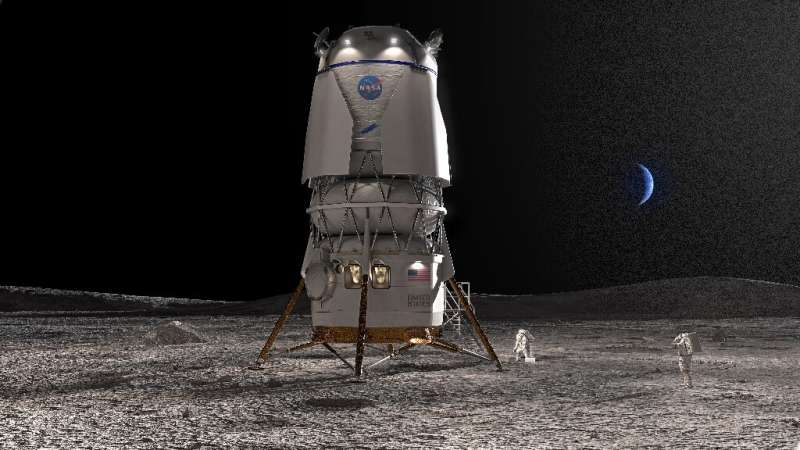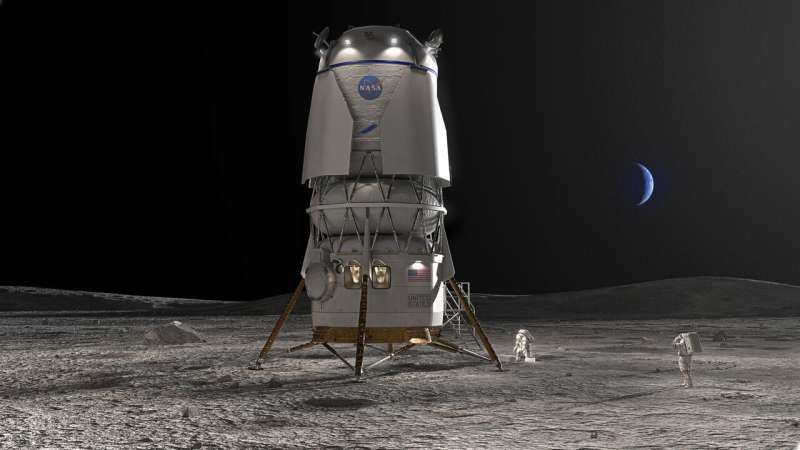Private mission carrying first Saudi astronauts to visit ISS set for launch
Sunday, 21 May 2023 07:21 A private mission to the International Space Station (ISS) organized by Axiom Space is due to blast off from Florida on Sunday, carrying the first two Saudi astronauts to go to the orbiting laboratory.
Rayyanah Barnawi, a breast cancer researcher, will become the first Saudi woman to voyage into space and will be joined on the mission by fellow Saudi Ali Al-Qarni, a fighter pilot.
The A
A private mission to the International Space Station (ISS) organized by Axiom Space is due to blast off from Florida on Sunday, carrying the first two Saudi astronauts to go to the orbiting laboratory.
Rayyanah Barnawi, a breast cancer researcher, will become the first Saudi woman to voyage into space and will be joined on the mission by fellow Saudi Ali Al-Qarni, a fighter pilot.
The A Agencies studying safety issues of LOX/methane launch vehicles
Saturday, 20 May 2023 21:56
Three U.S. government agencies are undertaking studies to examine the safety issues associated with a new generation of launch vehicles that use liquid oxygen and methane propellants.
SpaceX launches OneWeb Gen 2 technology demonstrator
Saturday, 20 May 2023 14:12
SpaceX launched a technology demonstration satellite for OneWeb’s second-generation broadband constellation May 20, along with spares for the British firm’s current low Earth orbit network and another that U.S.
Beam-hopping JoeySat launched
Saturday, 20 May 2023 13:00
An advanced broadband satellite that will demonstrate next-generation 5G connectivity by providing high-speed internet services has launched into space.
NASA selects Blue Origin as 2nd Artemis Lunar Lander Provider
Saturday, 20 May 2023 12:20 To develop a human landing system for the agency's Artemis V mission to the Moon, NASA has selected Blue Origin of Kent, Washington. Through Artemis, NASA will explore more of the Moon than ever before, uncovering more scientific discoveries, and preparing for future astronaut missions to Mars.
Blue Origin will design, develop, test, and verify its Blue Moon lander to meet NASA's human lan
To develop a human landing system for the agency's Artemis V mission to the Moon, NASA has selected Blue Origin of Kent, Washington. Through Artemis, NASA will explore more of the Moon than ever before, uncovering more scientific discoveries, and preparing for future astronaut missions to Mars.
Blue Origin will design, develop, test, and verify its Blue Moon lander to meet NASA's human lan NASA selects winners, announces final phase of Space Food Challenge
Saturday, 20 May 2023 12:20 NASA has announced eight winning teams and awarded $750,000 in prizes in the second phase of the agency's Deep Space Food Challenge. The winning teams will move on to compete in the third and final phase of the challenge.
As NASA prepares to send astronauts farther into the solar system than ever before, the agency needs food systems that can fortify future crews in deep space for years at
NASA has announced eight winning teams and awarded $750,000 in prizes in the second phase of the agency's Deep Space Food Challenge. The winning teams will move on to compete in the third and final phase of the challenge.
As NASA prepares to send astronauts farther into the solar system than ever before, the agency needs food systems that can fortify future crews in deep space for years at Pair of NASA weather satellites to launch from New Zealand
Saturday, 20 May 2023 12:20 A new pair of NASA weather satellites is ready for a ride into Earth orbit Monday from New Zealand. The launch time for the mission, called "Coming to a Storm Near You," is 1:30 a.m. EDT.
Called TROPICS, the Nos. 5 and 6 satellites are part of a constellation of extreme weather observatories, also known as CubeSats because of their small size and low weight.
The first successful TROP
A new pair of NASA weather satellites is ready for a ride into Earth orbit Monday from New Zealand. The launch time for the mission, called "Coming to a Storm Near You," is 1:30 a.m. EDT.
Called TROPICS, the Nos. 5 and 6 satellites are part of a constellation of extreme weather observatories, also known as CubeSats because of their small size and low weight.
The first successful TROP Georgia Tech to lead NASA Center on Lunar Research and Exploration
Saturday, 20 May 2023 12:20 Georgia Tech researchers have been selected by NASA to lead a $7.5 million center that will study the lunar environment and the generation and properties of volatiles and dust. The Center for Lunar Environment and Volatile Exploration Research (CLEVER) will be led by Thomas Orlando, professor in the School of Chemistry and Biochemistry.
CLEVER is the successor to Orlando's pioneering REVEA
Georgia Tech researchers have been selected by NASA to lead a $7.5 million center that will study the lunar environment and the generation and properties of volatiles and dust. The Center for Lunar Environment and Volatile Exploration Research (CLEVER) will be led by Thomas Orlando, professor in the School of Chemistry and Biochemistry.
CLEVER is the successor to Orlando's pioneering REVEA An X-ray look at the heart of powerful quasars
Saturday, 20 May 2023 12:20 Researchers have observed the X-ray emission of the most luminous quasar seen in the last 9 billion years of cosmic history, known as SMSS J114447.77-430859.3, or J1144 for short. The new perspective sheds light on the inner workings of quasars and how they interact with their environment. The research is published in Monthly Notices of the Royal Astronomical Society.
Hosted by a galaxy 9.
Researchers have observed the X-ray emission of the most luminous quasar seen in the last 9 billion years of cosmic history, known as SMSS J114447.77-430859.3, or J1144 for short. The new perspective sheds light on the inner workings of quasars and how they interact with their environment. The research is published in Monthly Notices of the Royal Astronomical Society.
Hosted by a galaxy 9. Beidou launches fifty-sixth Beidou navigation satellite
Saturday, 20 May 2023 12:20 The fifty-sixth Beidou navigation satellite, developed by the Fifth Academy of China Aerospace Science and Technology Corporation, recently took to the skies. The satellite is part of the geostationary orbit constellation and serves as the first backup satellite for China's Beidou-3 project.
Upon entering orbit and passing on-orbit tests, it will join the Beidou satellite navigation system
The fifty-sixth Beidou navigation satellite, developed by the Fifth Academy of China Aerospace Science and Technology Corporation, recently took to the skies. The satellite is part of the geostationary orbit constellation and serves as the first backup satellite for China's Beidou-3 project.
Upon entering orbit and passing on-orbit tests, it will join the Beidou satellite navigation system TransAstra receives Space Force contract to explore in-orbit propulsion systems
Saturday, 20 May 2023 12:20 U.S. orbital logistics and space mining company TransAstra Corporation announced Friday that the U.S. Space Force has awarded it a Phase One Small Business Innovation Research (SBIR) contract to explore new applications for the company's patented, propellant-agnostic Omnivore thruster.
The groundbreaking propulsion technology provides thrust typically six times faster and eight times cheap
U.S. orbital logistics and space mining company TransAstra Corporation announced Friday that the U.S. Space Force has awarded it a Phase One Small Business Innovation Research (SBIR) contract to explore new applications for the company's patented, propellant-agnostic Omnivore thruster.
The groundbreaking propulsion technology provides thrust typically six times faster and eight times cheap After SpaceX, NASA taps Bezos's Blue Origin to build Moon lander
Saturday, 20 May 2023 08:50
Two years after awarding Elon Musk's SpaceX a contract to ferry astronauts to the surface of the Moon, NASA on Friday announced it had chosen Blue Origin, a rival space company founded by billionaire Jeff Bezos, to build a second lunar lander.
Blue Origin's lander was selected for the Artemis 5 mission, currently scheduled to take place in 2029. The company will first have to demonstrate it can safely land on the Moon without a crew.
Bezos, the founder and former CEO of Amazon, said on Twitter he was "honored to be on this journey with @NASA to land astronauts on the Moon—this time to stay.
Technical strengths and lower cost led NASA to select Blue Origin lander
Friday, 19 May 2023 19:01
NASA selected Blue Origin to develop a second Artemis lunar lander because of technical strengths such as an aggressive schedule of test flights as well as its lower cost.
HASC chairman questions ‘continued delays’ in settling dispute over Space Command’s location
Friday, 19 May 2023 18:20
The chairman of the House Armed Services Committee Rep. Mike Rogers (R-Ala.
NASA picks Bezos' Blue Origin to build lunar landers for moonwalkers
Friday, 19 May 2023 16:51
Jeff Bezos' rocket company has won a NASA contract to land astronauts on the moon, two years after it lost out to SpaceX.
Blue Origin received a $3.4 billion contract Friday to lead a team to develop a lunar lander named Blue Moon.

